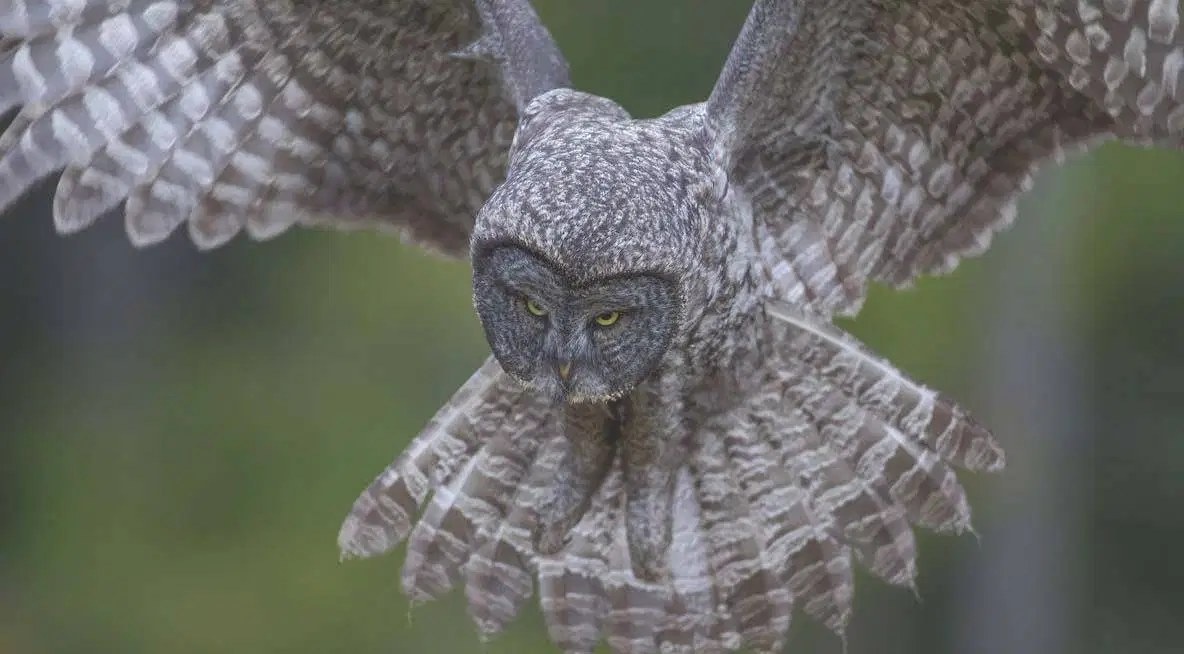
The mudflats of Bowerman Basin, just outside Hoquiam, are a key stop on the Pacific Flyway and come noisily alive each May with hundreds of thousands of shorebirds. The Basin is usually quiet during winter months, known mainly as a make-out spot for local teenagers, well fed from the neighboring Grizzly Den drive-in.
The exception is during a winter cold snap, when the Snowy Owl, largest of the species in North America, makes a majestic foray down to Grays Harbor . The great raptors also visit such spots as Boundary Bay, Discovery Park and the Skagit flats.

By Paul Bannick (The Mountaineers $18.95)
Photographer Paul Bannick is fixated on owls, author of the wonderful recent book The Owl and the Woodpecker. He has now produced two books for The Mountaineers, “Snowy Owl” and “Great Gray Owl.” Both are teaching documents designed to stir imaginations of all ages. I intend to bring “Snowy Owl” out to our family cabin on Whidbey, stand under a tree, and show pictures to Horny, our resident Great Horned Owl, closest kin to the Snowy Owl.
Bannick is immersed in study of his subject. He has produced unprecedented display pictures of Snowy Owl mating rituals. He notes that while the Arctic looks flat to the untrained eye, “its ubiquitous contours are critical to the Snowy Owl’s survival. The owls nest on tundra locations that feature prominent raised sites, which are also useful for nesting and hunting.”

By Paul Bannick (The Mountaineers $18.95)
Great Gray Owls are nocturnal and inhabit boreal forests of North America and Eurasia. Bannick long wondered how such a large owl could maneuver through dense stands of trees. “Although the Great Grey possesses a huge frame,” he writes, “it is composed mostly of soft, flexible feathers that easily bend if they come into contact with branches, allowing the owl to squeeze through narrow gaps.”
Bannick takes time out to photograph the owls’ neighbors. Woodland caribou and members of the weasel family inhabit boreal forests with Great Gray Owls. Loons, ptarmigan, polar bears and Arctic foxes are tundra neighbors of the Snowy Owl. One of Bannick’s striking shots shows a Snowy Owl attacking an Arctic fox.
Over the past few years, Bannick’s greatest shot has graced the lobby of Snowy Owl Theater at the Sleeping Lady retreat outside Leavenworth. (Bannick took retreat founder Harriet Bullitt and sister-in-law Tina Bullitt down to Bowerman Basin to watch the owls.)
The picture, printed for the first time, shows five Snowy Owls, doubtless arrived out of interior British Columbia via the Fraser River. They are sitting on the shore of Boundary Bay, just over the border in B.C., with 10,778-foot Mount Baker as a majestic backdrop. The mountain lives up to its native name roughly translated as the “Great White Watcher.”
Owl populations wax and wane with favorite prey — lemmings with Snowy Owls and voles with Great Gray Owls.
“An indicator species is one whose presence and relative abundance assists in evaluating the health of an ecosystem,” Bannick writes. “So understanding Great Gray Owls and preserving their habitat helps us protect a variety of other species, which in North America might include Boreal Owls, Northern Hawk Owls, Spotted Owls, Northern Goshawks, woodland caribou, elk, fishers, grizzly bears and lynx.”
The author’s worries for the Snowy Owl are more direct. The Arctic is warming. Industrial depredations threaten the birds’ breeding habitat. Breeding habitat is being pinched off by man, and “melted off” on both its northern and southern edges. The owls nest on a very thin band of tundra between boreal forest and the Arctic Ocean. Climate change is melting the permafrost, allowing deep rooted plants to take hold further north, and eliminating lemming habitat.
Resource extraction threatens some prime Snowy Owl nesting habitat, particularly in the National Petroleum Reserve west of Alaska’s Prudhoe Bay oilfield. The Obama Administration tried to balance extraction and preservation, with special attention to bird habit and wetlands. The Trump Administration has produced a throw-it-open, drill-baby-drill plan.
Baby owls are fluffy, wide-eyes and irresistibly cute, as Bannick records in his nesting pictures. A very different picture is provided when the great birds are plunging downward and dismembering prey. A raven vs. Snowy Owl faceoff is one of Bannick’s best shots.
We will hopefully have a cold snap this winter. It will be time to displace the smooching teenagers at Bowerman Basin – after a stop at Grizzly Den – or head for the Skagit, or the Reifel bird refuge near the mouth of the Fraser River. We may still be banned from British Columbia, so will wait for Snowy Owls to come to us from the Great White North.
Buy Bannick’s books, pack your telephoto lens, and hope for a Snowy Owl shot with the Great White Watcher as backdrop.
